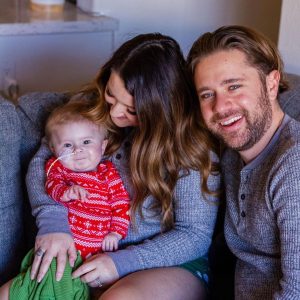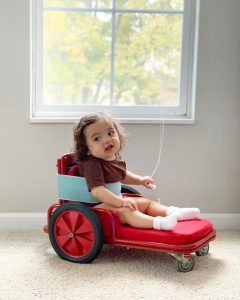Parents of 2 Babies Treated with Zolgensma in July: We Made the Right Choice
Written by |

Tora Patgiri, left, and Stella Lackey were treated with Zolgensma in July 2019. (Photos courtesy of families)
The parents of two babies treated in July with Zolgensma, the first gene therapy approved for spinal muscular atrophy or any neuromuscular disease, are confident they made the right choice for their girls.
Both families also said they would make the same decision today, with minor adjustments.
“If you put us back in our shoes on June 18, when we got our very first diagnosis … I don’t think we would have changed a thing,” said Jeremy Lackey of Scottsdale, Arizona, whose type 1 SMA daughter, Stella, was treated on July 3.
“Yes, yes. Absolutely the same choice,” said Rajdeep Patgiri of Columbus, Ohio, who came from Britain with his wife, Taisiya Usova, and their daughter for the gene therapy. “The route that we followed is probably better than anything else we could have thought about.”
Their daughter Tora, who was diagnosed with type 1c in London and type 2 in Ohio, was 10 months old when she was given her treatment, also by intravenous infusion, on July 25. She was among the first of older babies given Zolgensma by IV; in clinical trials, the treatment relies on intrathecal (spinal cord) injection for infants older than 6 months, a route that is not approved.
“You need a lot of patience, because it’s not a miracle,” Patgiri said. “Nothing changes overnight. The changes come in very small steps.”
Sometimes, more than a week will pass with Patgiri or Usova thinking no new skill has been gained by their daughter — but then they’ll call their families in Russia or India and be told: no, that’s new.
“They notice the changes much more than we do,” watching Tora every day, Patgiri said.
Read more about Zolgensma
SMA News Today first interviewed Jeremy and Samantha Lackey about Stella and their experience getting and going through Zolgensma treatment, and spoke with Patgiri about his family’s Zolgensma journey, in July.
We checked back with them this month, and they talked openly about their post-treatment lives and day-to-day challenges, with the hope that what they’ve learned might help others.
“At end of day, no matter what happens with your child, you’re going to do whatever it takes to help them,” Lackey said. “That’s the message we’d like to send: Whatever it takes to help your baby, to give your baby the best opportunity, you’re going to do it.”
Progress is evident, in the context of SMA
The girls’ progress is not leap-frogging ahead. But SMA is a severe and progressive disease, with motor neurons dying quickly because of mutations in the SMN1 gene that leaves it producing little or none of the SMN protein essential for muscle health.
Type 1 is SMA’s most severe form, and Stella was visibly laboring to breathe by mid-June, shortly before her treatment. Tora, a borderline type 2, did not show any respiratory issues, but was starting to choke on liquids two weeks before her Zolgensma date.
“That stopped almost immediately after the infusion. A week later, her swallowing was back to normal,” Patgiri said. “We are probably somewhat frustrated that she’s not improving as fast as she could be, but that’s a good problem to have.”
In the five months since, the 15-month-old can “roll a full 360” when lying down, and kneel if she holds on to a couch or a pole, her father said. She can move her legs easily back and forth horizontally, but still cannot lift them against gravity.
But kneeling shows that she can bear a little weight on her legs, which she could not pre-treatment, and the family is trying to get a standing frame medical device to further develop her leg muscles at home and at her weekly physical and occupational therapy sessions.
The greatest visible progress came in the early post-treatment months, with lesser gains evident to her parents since. Her “strength is much better than before,” Patgiri said. “But I would say that her progress is slightly slower than some of the kids who were treated around the same time as her.”
Tora is in somewhat uncharted territory, he added, because most children her age treated with Zolgensma by IV infusion had previously been using Spinraza (nusinersen), the first approved SMA treatment.
“We ask what could be possible for her — walking, standing unassisted, whatever. And their response is mainly that, well, there’s no data,” he said.
Unlike Zolgensma (by AveXis and Novartis), which brings a healthy copy of the SMN1 gene to motor neurons, Spinraza (by Biogen) works to boost a similar gene — called SMN2 — so that it can produce sufficient amounts of a functional SMN protein. Without Spinraza, SMN2 naturally produces a very short protein that quickly degrades.
Patgiri and his wife are in close contact with some parents of toddlers much like their daughter, and say that those who were treated with Spinraza prior to Zolgensma were a lot stronger and may be progressing more quickly for that.
“Tora has started to bear some weight through her legs, but not as much as some of the other kids,” he said. “That’s probably the difference where we are at the moment.”
Lackey thinks Stella’s progress has been fairly steady and definitely heartening. Treated at 7 weeks old, she’s showing improvements “at least every week … doing something new or she’s getting even better at something that may have been new a few weeks ago.”
From “zero head control” in June, the 7-month-old is now able to sit with support and “hold her own head for a couple of seconds, sometimes up to 10, before it might ‘flop’ in one direction or another,” her father said. “She continues to kick her legs and flail her arms … and she’s started to work on grabbing things, and she’ll hold her own bottle.”
She, too, goes to regular physical therapy, which both parents think is essential.
But such milestones, Lackey said, are milestones in the context of SMA and Zolgensma.
“We really don’t know what the future holds,” he said.
Patgiri thought much the same.
“Probably 10 years ago, SMA [type 1] would be … a death sentence. Now, that’s not the case. But whether treatment will allow a child to become a fully normal person … we cannot be 100% sure yet,” he said. “We are hoping for continuous improvements, but we don’t know what the limit will be.”
Breathing became difficult for Stella again in early September, around the Labor Day holiday, for reasons that baffle her neurologist, her pulmonologist, and her parents.
The baby was being weaned from prednisone, a corticosteroid required for a few months after Zolgensma treatment — Stella was on it for two and a half months — when she began to struggle to breathe as if “something had gone down the wrong pipe,” Lackey said. (Tora was on prednisone for more than four months until her liver enzyme levels returned to near normal).
His wife, Samantha, decided to take Stella as a precaution to Phoenix Children’s Hospital where she had been treated in July. “We’re really glad we did,” he said.
Stella would spend the next three weeks at Phoenix, her breathing assisted with a BiPAP mask. The cause of her breathing problems is still “genuinely unknown,” Lackey said, and likely will remain so.
“If it was SMA-related, if it was Zolgensma-related, if it was just a freak little bug, an accident [in swallowing] — we really don’t know,” he said.
But the scare led the parents to the only real change they would have made to Stella’s care after Zolgensma — getting her on a BiPAP.
“That [the BiPAP] has helped tremendously, kind of in her energy levels,” Lackey said, adding that Stella now uses it only at night and for long naps. “It helps her get good, solid rest, and not burn calories just based on how hard she has to breathe at night.
“In hindsight, we wish we had gotten her on breathing support sooner,” he added.
Readers can follow Stella’s story — in words, photos, and video — on her Instagram page: stronglikestella.
It’s hard to put a price on help
Both families praised their respective private health insurance carriers — Cigna for the Lackeys, United Healthcare for the Patgiris — for being consistently reliable in covering Zolgensma’s record-setting price ($2.125 million) for one-time use, and assorted costs of continuing care.
The Lackeys also keep a “very good relationship” with Beth Manogue, the patient assistance manager assigned to them through AveXis’ OneGene Program, which was created to guide SMA families through Zolgensma treatment. They check in with each other regularly.
The Patgiris, in contrast, met with their resource manager twice, remembering a OneGene representative checking with them and Tora during treatment and the months-long follow-up period of blood tests and exams. But “beyond that, we don’t have anything more,” he said.
Neither family is planning to request Spinraza infusions or a similar but potential oral therapy called risdiplam (by Roche; now under FDA consideration for approval), though both plan to review their options around the one-year mark, in July 2020.
“We’re just looking to take it day by day and week by week … and not necessarily try to immediately seek out any sort of supplementary treatment,” Lackey said.
“I think that kind of circles back to how things are going well as it is. If … she was struggling or not improving so much on Zolgensma, then yes, we would probably be having a different conversation,” he added.
Again, when all is said and done, both families would largely do exactly what they’ve chosen to do — even if it costs $2.125 million.
“It’s hard to put a number on the fact that we are not anxious about, say, regression in terms of her swallowing, in terms of her breathing, in terms of her losing movement,” Patgiri said. “It’s hard to put a number on that. … As a parent, I think it’s definitely worth $2 million or whatever.”
“I don’t know how to answer that,” said Lackey, noting his insurance — not his family alone — covered Zolgensma’s cost. “Yes, there are people out there who have [raised the funds], and there are people who are trying to raise that money. We thankfully didn’t personally have to.
“But I think at the end of the day, regardless, we would do something that costs $5 million to get Stella what she needs to help her, to give her the best opportunity to live the best life.”










